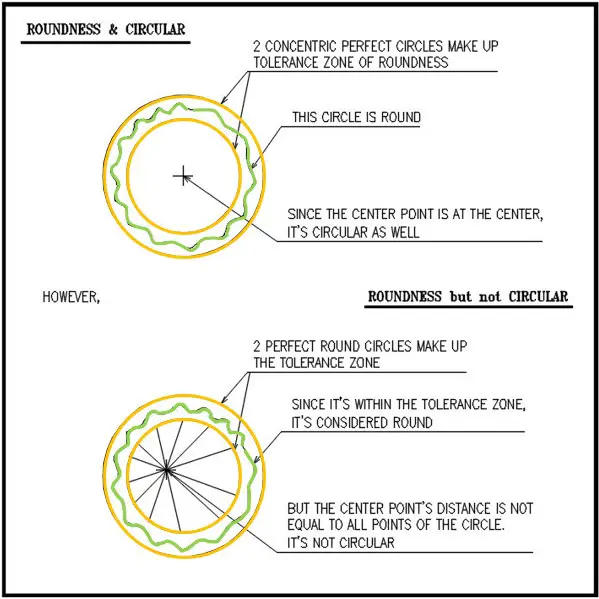Wondering how roundness and circularity are different? Or both are actually the same? How to express them in terms of tolerance? We’ll be discussing it here.
Roundness
In simple words, the term roundness is defined as a value that is used to compute the errors that appear in a perfect circle. In other words, roundness can be replaced by the term circularity.
And most of the time in typical engineering terms, roundness and circularity are interchangeable. As it is clear that the circle is a 2-dimensional feature, roundness only applies on a 2-dimensional profile.
According to the International Standard of Organization (ISO), roundness is defined as a ratio of inscribed and circumscribed circles radii. i.e. the maximal and minimal sizes for circles that are just enough to confine and form a particular shape.
The tolerance zone of roundness lies between two concentric circles of the cross-sectioned parts as shown in the given figures.
If all measured points on the surface lie within the space between those two concentric circles, the recorded and the measured result of roundness is marked as Approved or Pass as shown in figure 1 below.
But if the measured point of the examined surface conflict or is diverted from the allowable region the recorded result of roundness is marked as FAIL or rejected as shown in figure 2.

Circularity
A basic and simple description of a circle is a feature having the same value of all radii from its center point. The term circularity is used to exhibits how close an object should be to a true circular nature.
Circularity is when all points of a body at any cross-sectioned area are equidistant from a reference axis. It is a 2-dimensional tolerance range that ultimately controls the overall geometry to form a circular body. Its value ensures the considering object is not too oblong, out of round, or ellipse in nature.
The major difficulty that arises during the inspection of the circularity of any object is:
- the need to cross-sectioning the object in order to obtain the value of lower variation or
- by the use of high precision coordinate measuring machine.
Both these methods (CMM method and cross-sectioning method) can be used for the limited samples only. If we consider inspecting all the units as the Quality Control is bound to do that, the cost of such inspection method might exceed the cost of the product. Moreover, the availability of such expensive machines might not possible in every production and manufacturing industry.
Geometric symbol
Both circularity and roundness are represented with the same geometrical symbol. Datum Axis is not required for roundness and circularity.
Measuring Method
There are numerous ways to measure the value of roundness and circularity. There is a list of measuring tools and methods used for the quality inspection of Roundness and circularity.
- Diametral
- Dial gauge / Dial Indicator
- V Block types
- Coordinate measuring Machine
- Star Probe
- Mindrill
Applications
There is a huge list of real-life applications, roundness and circularity are massively used in automotive and production industries, for instance, in the production of Wheel hubs, brake drums, brake discs, shafts, and rollers, pistons, and also for the machining pod and parts.
